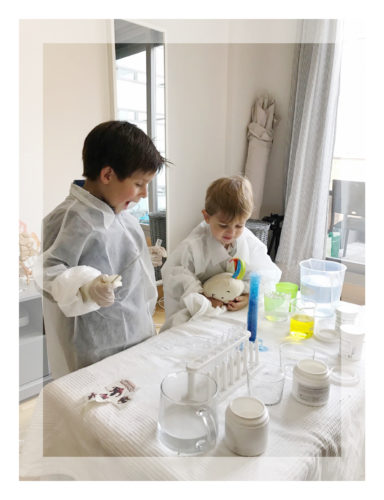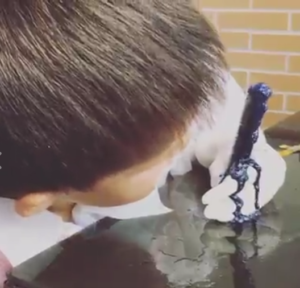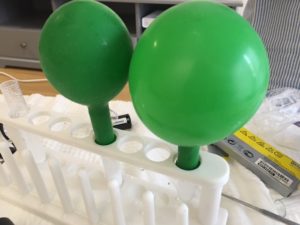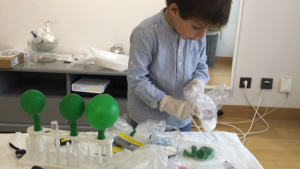EXPERIMENT SHEET
| Theme | pH, Acid-base reactions |
| Category | Chemistry Experiments, Experiments for children |
| Main product | Citric Acid, Sodium Bicarbonate |
| Short description | For anyone who has sat down to do experiments with children, especially under the age of 6, you will have noticed that it is really tricky. They touch everything, they put their hands to their faces after touching products and it is difficult not to drop something. The experiments using citric acid and baking soda are great to do with young children. They make a rapid and visible reaction, which children love. It is also a controlled reaction (it won't be too strong) and both citric acid and baking soda are food additives, if they put it in their mouths they are taking food additives with them. |
We will also use food colouring for this experiment to add a little colour to the experiments. Citric acid can be replaced with vinegar. I prefer citric acid because it is cleaner (it comes in powder form) and leaves no odour.
Below, after the experiments, you can see the theory of the reaction between citric acid and sodium bicarbonate and understand the importance of the reaction and what is generated.
CITRIC ACID AND BICARBONATE EXPERIMENTS

EXPERIMENT 1: VOLCANO/LAVA
The volcano experiment or lava is one of the best known science experiments for children. However, it is still a great experiment, in which the scientific basis is just as important as in more complex experiments.


Materials needed:
- Citric Acid (vinegar can be substituted)
- Sodium bicarbonate
- Food colouring (optional)
- Spatula/spoon (optional)
See experiment: Volcano Experiment
EXPERIMENT 2: SELF-INFLATING BALLOONS
The self-inflating balloon experiment is similar to the volcano experiment. In this case CO2 (gas generated in the reaction) is used to inflate balloons. The only thing you have to take into account is that you have to use a beaker or a tube with a nozzle where a balloon fits. That is why we use test tubes.


Materials needed:
- Citric Acid (vinegar can be substituted)
- Sodium bicarbonate
- Laboratory tubes
- Test tube rack
- Balloons
- Spatula/spoon (optional)
See experiment: Self-inflating balloons experiment.
EXPERIMENT 3: ROCKET
This rocket experiment They will love it. The difference between this experiment and the volcano and balloon experiments is that in this case we are going to close the container. The closure must be airtight, but easy to release. In this way, as the gases are generated inside, there will come a moment when the pressure of the gases on the container will be greater than the force of the lid that closes the container. At this point the container will fly upwards like a rocket.
Materials needed
- Citric Acid (vinegar cannot be substituted in this case, as it is needed in powder form).
- Sodium bicarbonate
- Container with lid. Airtight but easy to open closure.
- Paper napkin
See experiment: Rocket Experiment
EXPERIMENT 4: PH measurements
At this experiment we are going to play with the pH. Citric acid and sodium bicarbonate base their reaction on the pH difference, so we will try to balance the reaction until we get a neutral pH equal to 7, at which point the reaction will be completely balanced.
Materials needed:
- Citric Acid (vinegar cannot be substituted in this case, as it is needed in powder form).
- Sodium bicarbonate
- Test tubes
- Laboratory rack
- Phenol Red
- pH meter
See experiment: pH measurements of liquids we have at home
THEORY: REACTION BETWEEN CITRIC ACID AND BICARBONATE
The reaction that takes place between citric acid and sodium bicarbonate is a acid-base reaction. As we told you on the acid-base reactionsThese reactions are one of the most important reactions in nature, in the ocean and in our bodies in natural processes.
Acid-base reactions can be mild (as in the case of citric acid and sodium bicarbonate) or they can be more violent and exothermic. The latter would be the case for hydrochloric acid (HCl) and sodium hydroxide (NaOH).
Let's look at the reaction between citric acid and sodium bicarbonate. The reaction takes place in 2 steps, ending in an equilibrium between a sodium citrate salt, carbonic acid (H2CO3), water (H2O) and carbonic oxide (CO2). The carbonic oxide, CO2, is the one that comes out as a gas and allows these 2 compounds to produce a visible and amusing reaction. CO2 is not a toxic gas (it is a compound that is part of the air), therefore the gas that is generated is not dangerous, and it is OK to be around when it is generated. There are other reactions with other compounds that can be very dangerous as they can give you hydrogen gas H2 (flammable), or chlorine gas Cl2 (toxic)), but in this case, it is a very controlled reaction and is not toxic.
C6H8O7(aq) + NaHCO3(s) -> C6H5O7Na3(aq) + 3 H2CO3(aq)
C6H5O7Na3(aq) + 3 H2CO3(aq) C6H5O7Na3(aq) + 3 H2O(l) + 3 CO2(g)
The reaction is in equilibrium, i.e. not all H2CO3 is used up, but a little H2CO3 remains in solution.
Therefore, adding sodium bicarbonate to the citric acid solution forms the sodium citrate salt (C6H5O7Na3) and carbonic acid (H2CO3), which rapidly decomposes to a large extent into water (H2O) and carbonic oxide (CO2).

Can citric acid be used to produce a transparent liquid that will flash in the sunlight? With what other chemicals should I make this glaze when in contact with something at a high temperature the liquid changes to a dark brown colour?
I have sour oranges if I squeeze them and add baking soda, will it become drinkable? Will it lower the acidity level of the citrus?
Hello, yes it would lower the acidity level by counteracting it with a base, but we do not recommend doing experiments related to food without knowing what you are doing/calculating quantities etc...
For one kg of peeled lemons, how much bicarbonate should we add to make lemon marmalade less acidic?
How do I calculate the pH of the volcano solution?
help me tomorrow I have to hand in 2 experiments for chemistry these have to be about neutralisation, can you help me with some of them, I am in the first year of secondary school.
Hello
I use citric acid and bicarbonate, for the CO2 in the aquarium.
It turns out that I've got a sticky spot in the tank and there's no way to remove it.
How or with what could I undo it?
Because it seems impossible to me, not even with a clean hammer blow.
Thank you in advance.
Hello Jose
Normally, the sticking is either citric acid or bicarbonate. To remove them, depending on whether it is one or the other, the best thing to do would be to put: Salfuman (if it is bicarbonate) or Caustic Soda (if it is citric acid). As soon as you put one of the 2 you will know which one it is as it will start reacting very fast. If it doesn't react, try the other one.
It should be noted that both Salfuman and soda are strong reagents, so they should be used with gloves, a mask and never mixed. Both can be found in a common supermarket, normally in the paint section, or soda as a plunger. It is important to use them very slowly and with extreme caution.
I hope you find it useful.